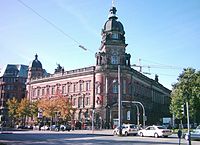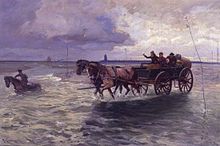Museum for Communication Hamburg
 Building of the old post office, former seat of the museum |
|
| Data | |
|---|---|
| place | Hamburg |
| Art |
Post and communication
|
| opening | 1937 |
| Number of visitors (annually) | 50,000 (2003) |


The Museum for Communication Hamburg (between 1966 and 1995 “Postmuseum am Stephansplatz”) was a museum for telecommunications and post in Hamburg , which was closed to visitors on October 19, 2009 and subsequently dissolved.
The museum was located in the former Oberpostdirektion on Stephansplatz (entrance Gorch-Fock-Wall), which is named after the general postmaster Heinrich von Stephan . The listed building was built as the Oberpostdirektion, post office and telegraph service building from 1883 and its representative design is also an expression of the postal conditions newly regulated by Stephan.
The museum was originally mainly devoted to the history of the post , in particular the German postal history as well as in relation to Northern Germany (→ Napoleonic Post in Northern Germany and Northern German Post District ) and the postal history of Hamburg . Later, the focus was on the history of communication from more than 4 centuries, i.e. the representation of the entire development of communications in the postal and telecommunications sectors up to the present day. Starting with Hamburg as the largest German seaport, the special requirements that the coast and the sea place on the transmission of messages formed a special focus.
The museum belonged to the Museum Foundation Post and Telecommunications and, in addition to the permanent exhibition, also showed temporary exhibitions.
history
The museum was established in 1937 on the 40th anniversary of Heinrich von Stephan’s death. And went back to the "Postal History Collection". This was originally issued in separate rooms of the post office at Dovenhof . During the war, the collection was moved to Ahrensburg until it moved into the current building in 1949. In 1966 the telecommunications part was reorganized and the museum was officially named the Postal Museum. For the 50th anniversary in 1987, the Post Museum was opened with a new concept after the collection of telecommunications history, which was housed in the Museum of Hamburg History until 1984 , was merged. Subsequently, historical marine radio devices and workplaces could be secured for the museum, thus expanding its maritime focus.
In 1995 the museum was separated from the now privatized and newly founded Deutsche Post AG and Deutsche Telekom AG , renamed the Museum for Post and Communication (so until 1999) and with the museums in Berlin, Frankfurt am Main and Nuremberg into the Museum Foundation Post and Telecommunications transferred. The old post office building was sold to a private investor for 50 million marks and the museum space was rented. Between 1995 and 1999, the permanent exhibition was revised and the areas for temporary exhibitions were enlarged so that a total of 1400 square meters were available.
The number of visitors rose from 8,000 (1995) to 50,000 in 2003 and thus recorded the highest increase of all Hamburg museums. There was also a high proportion of children among the visitors who, in the first children's museum test in 2006, voted the house next to the Museum für Völkerkunde Hamburg the most popular museum.
Exhibits
The exhibition was structured according to the communication channels on land, under and above water and through the air. The focus of the Hamburg museum was the communication channels on the oceans. It showed the history of communication and its increasing speed from the Hamburg messenger to the satellite telephone . A car of the Watt Post , a lip-capsule of the spacecraft Voyager , a pneumatic tube system ( pneumatic tube in Hamburg ), a part of the first transatlantic cable , one in 1582 in Hamburg of sent by ship letter, telegrams from the RMS Titanic or the mobile phone Vertu Signature Gold from 18-carat yellow gold were among the numerous exhibits.
Visitors were able to take part in a number of objects themselves and try out tools for communication from different eras, such as writing with a quill pen , using teletypes or modern internet workstations for themselves.
The museum also organized post-historical tours on one of the last surviving post launches , which were used to carry mail to the ships in the port of Hamburg until 1945. In the museum, a diorama showed the scene of such a mail delivery on a ship.
closure
On July 7, 2009, the Museum Foundation's Board of Trustees planned to give up the museum in mid-2010 and it was decided to close it to the public on October 18, 2009. The reason given for this was the intention of the owner of the old post office directorate to build a clinic there. According to the Museum Foundation, the merger with another Hamburg museum is not possible because there is not enough money available to set up the museum at another location. The building of the Oberpostdirektion changed hands again in 2007. The museum's lease, which was originally valid until 2023, has now been canceled by the owner. The reasons for the closure are less the number of visitors, which have increased in recent years, but rather cost-cutting measures at Deutsche Post and Deutsche Telekom, the sponsors of the museum foundation.
The closure has been discussed several times since the postal reform, including a move to the museum ship Cap San Diego . In 2004 the budget was cut from 1.4 to 1.2 million euros and one job was cut.
The museum's exhibits, including valuable evidence of Hamburg's history , were stored in the foundation's depots.
literature
- No new location, due to the closure of the Museum for Communication in Hamburg , interview with Lieselotte Kugler, curator of the Museum Foundation Post and Telecommunications. In: THE ARCHIVE magazine for communication history . Vol. 57, No. 4, 2009, ISSN 1611-0838 , pp. 54-55
Web links
Individual evidence
- ↑ Broadcast: The last day at the Museum for Communication Hamburger Abendblatt from October 19, 2009
- ↑ The Museum for Communication celebrates its 70th birthday. Media information on history and anniversary ( page no longer available , search in web archives ) Info: The link was automatically marked as defective. Please check the link according to the instructions and then remove this notice. dated June 21, 2007, as a PDF file
- ↑ There will soon be no more mail from the Hamburger Abendblatt of August 26, 2009
- ↑ Last days at the Museum for Communication Hamburger Abendblatt on October 7, 2009
Coordinates: 53 ° 33 ′ 28.4 " N , 9 ° 59 ′ 16.7" E
